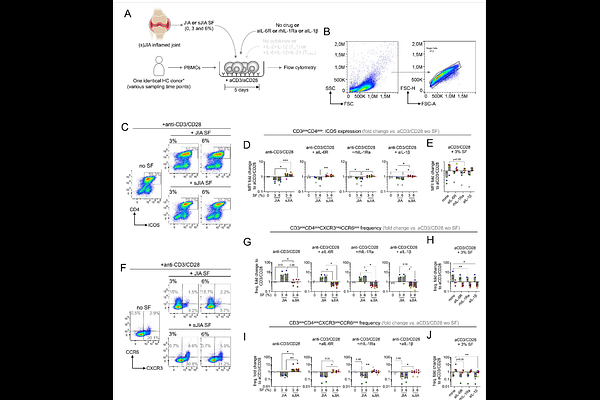The systemic JIA synovial fluid environment supports development and prevalence of specific inflammatory T helper cell phenotypes

The systemic JIA synovial fluid environment supports development and prevalence of specific inflammatory T helper cell phenotypes
Schleifenbaum, S.; Swoboda, A.; Dirks, J.; Bracaglia, C.; Caiello, I.; Hinze, T.; Hardt, S.; Prencipe, G.; Tarantino, G.; Pardeo, M.; Fuehner, S.; Park, C.; Hinze, C.; Wittkowski, H.; Windschall, D.; Foell, D.; Morbach, H.; Kessel, C.
AbstractObjective: The potential involvement of adaptive immunity in systemic juvenile idiopathic arthritis (sJIA) pathophysiology remains an intriguing question. Here, we investigated whether and how the inflammatory environment in sJIA versus JIA synovial fluid (SF) may differentially impact T helper (Th) cell polarization and activation. Methods: SF samples from sJIA and JIA patients (both n=7) were tested in various cell culture setups, with or without recombinant cytokines or cytokine-blocking drugs, to assess their effects on healthy donor Th cell activation. We analyzed cellular surface marker, transcription factor, and effector molecule expression using flow cytometry, Luminex, ELISA, and qRT-PCR. Results: Both sJIA and JIA SF revealed highly pro-inflammatory profiles. Compared to JIA, sJIA SF demonstrated markedly elevated IL-1{beta}, IL-18, GM-CSF, S100A9, and MPO levels, while JIA SF showed trends toward higher soluble FasL and IL-17A concentrations. Notably, sJIA SF significantly increased CD4 T cell ICOS expression and expanded CXCR3posCCR6pos Th cells, whereas JIA SF favored expansion of CXCR3negCCR6pos Th cells and CCR6pos Th cell expansion was sensitive to IL-1 blockade. Systemic JIA SF selectively sustained a IFN{gamma}/IL-21 expressing T peripheral helper (Tph) phenotype, particularly associated with IL-1{beta}, IL-18, and GM-CSF SF levels. Spiking JIA SF with a cocktail of these cytokines recapitulated some T cellular phenotypic features observed in sJIA SF cultures. Conclusion: JIA and sJIA SF drive distinct Th cell polarization, including differential and sustained Tf/ph cell activation. These findings complement our earlier observations in sJIA peripheral blood and demonstrate the impact of the SF inflammatory matrix on immune cell activation.